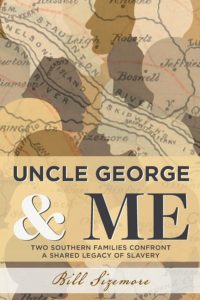Uncle George & Me: Two Southern Families Confront a Shared Legacy of Slavery

BY BILL SIZEMORE
BRANDYLANE PUBLISHERS, 2018
158 PP.; $18.95
Bill Sizemore has written a little gem of a book. In Uncle George & Me: Two Southern Families Confront a Shared Legacy of Slavery he explores details of his own family history and the larger history of racism in America with enlightened understanding, honor, and compassion. More importantly, he does so without glossing over the horror of slavery.
It begins simply enough. Sizemore, a retired newspaper editor, finds out through the most basic research that he’s descended from slave owners, a fact that rightly horrifies him but also intrigues him. Tracing his family roots back through court records and other sources he learns that his great-great grandfather expanded his slaveholding from fourteen to twenty slaves at the start of the Civil War. His great grandfather fought for the Confederacy (a fact that, unlike the slaveholding, had been passed down in the family). Sizemore finds a picture of the family’s house at the time—no Southern mansion but rather a very small clapboard house with only two rooms and an upstairs loft. He points out that this small ancestral home doesn’t lessen how striking slavery was but instead illustrates how widespread the practice was.
Sizemore then discovers that not only did his family own slaves, their descendants are still living in the area and share the Sizemore surname. The families have had no contact in almost 140 years.
Thanks to the internet, Bill is able to connect with family members who quickly direct him to Uncle George Sizemore, the family historian of the enslaved Sizemore clan, who, in his nineties, is amazingly only one generation removed from slavery himself; Uncle George’s father was owned by Bill Sizemore’s family. Through Uncle George and his welcoming, gregarious charm, Bill is connected to the large, sprawling family that still gathers for family reunions.
Despite the family histories, Bill is generally welcomed and directed to those willing to share their subsequent experiences. His own family actually seems more reluctant to have this history explored, though eventually a large gathering of both families takes place.
From here the author narrates stories of the slave-descended Sizemore family to illustrate the larger issue of race and the black experience in America—how newly freed members of the family tried to reclaim their lives with varying success and failure, some by staying in Virginia, some by moving north either after the Civil War or in the Great Migration of the 1930s and ’40s.
The stories continue through the 1960s and ’70s right up to today, including his meeting with Howard el-Yasin, a member of the staff at Yale University who gave up the Sizemore family name due to its probable connection to the family that owned his forbears.
Throughout it all, Sizemore’s research and writing are excellent, and his journalist’s eye for catching and recording the telling details and illustrative experiences is unerring. Especially in the second half of the book, members of the slave-descended Sizemore clan tell their own stories, and the pages pass by all too quickly while still telling a rounded, vivid history of slavery and racism that has still, unfortunately, not played out completely.
Uncle George & Me would be an important story to explore and be reminded of at any time, but it seems especially timely in this era of Charlottesville and Black Lives Matter. Indeed, it’s sobering to realize just how personal and common this history is.
